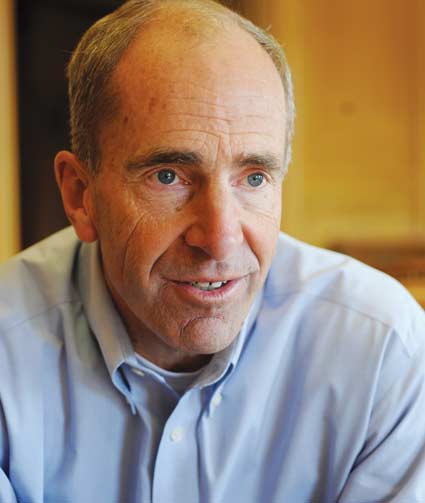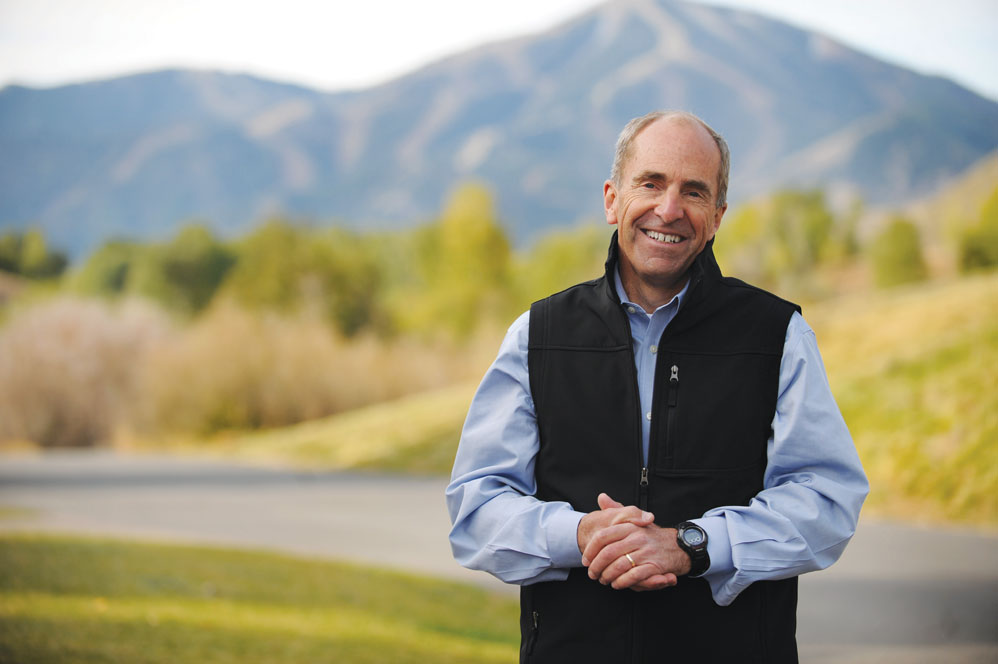| The Man Behind the Mountain
The prodigal son returns to shake up the dowager resort.
Van Gordon Sauter sits down with Tim Silva,Sun Valley’s new general manager.
For Tim Silva, the new vice president and general manager of Sun Valley Resort and all its fabled domains, numbers count. In particular, 9s and 10s. Departing resort guests are asked to rate their stay at the resort on a scale of 1 to 10. It is not a frivolous exercise. For the guest, it is a blunt appraisal of performance. For the resort, it is a tool that measures effectiveness and foreshadows the future. A critical box score.
The 6s and below are lost souls, guests who didn’t bond with Sun Valley. The 7s and 8s enjoyed their stay, and may return, but most likely will not be recommending Sun Valley. They will not generate new visitors. But the 9s and 10s? Ah, the rapture of a 9 or 10. The nectar of the innkeeper. These visitors become missionaries, troubadours of the Sun Valley experience, spurring their friends and family to book into the resort. These people, with their 9s and 10s, are the evangelistic multipliers of new business.
It was a quiet morning in Gretchen’s restaurant at the Sun Valley Lodge, just after the Labor Day holiday. The tranquility was a welcome contrast to the prior morning when families, their vacations concluded, deadlines beckoning, energy frayed, flailed through breakfast before setting off to Friedman Memorial Airport in Hailey or the long grind over Highway 20 to the Boise airport. The only tangible sensitivity for the restaurant staff this morning was a man sitting at a table near the back of the room, talking with a visitor, a reporter. The man, balding, gracious, informally dressed, wearing a black North Face jacket over a spiffy, button-down blue dress shirt that conveyed an understated authority, is the resort’s general manager.
Tim Silva is a professional, seasoned resort executive with a sobering range of responsibilities. He takes over the day-to-day operation of Sun Valley Resort from his predecessor Wally Huffman at a crucial point in its history. Earl Holding, the resort’s owner, has made remarkable investments, financially and conceptually, in the property, seemingly far out of proportion to any short-term return. And everything is top of the line. From the pavilion to the new golf course to the enormous clubhouse to the mountain gondola, Sun Valley is poised to achieve a new identity.
The 57-year-old Silva is adroit at answering questions, and smooth in rejecting assumptions he finds baseless, such as this reporter’s flip query, “Why does the food at Sun Valley suck?” (See page 30 for the answer). His iPhone is never far from sight, though his attention to the conversation never wanes. Silva, a man comfortable with his job and his environment, has an MBA’s unrelenting passion for quality and focus on product and performance.
In spite of a frumpy uniform, the waitress serving us is cute and poised, unflustered by the presence of her boss. She picks up a half-empty Diet Coke with extra ice to get a refill. But then, as she pivots to make her way to the soda machine, she loses her grip. The glass, nearly a quarter full, slips from her hand. It doesn’t drop, but arcs out, ahead of her, descending at an angle toward a wall next to the table.
One senses a sudden awareness in Silva’s face. He is witnessing an accident impossible to interdict. All the metrics and accountabilities and proof of performance skills are incapable of mitigating a possibly nasty event. The crash produces the nerve-rattling sound of smashing glass, of ice and shards of glass scattering across the floor. Silva is rising from his chair, his hand reaching out for the employee.
“Are you all OK?” he asks with quick sincerity, afraid the shrapnel sliced a leg or foot. She is fine. A cleanup person is quickly at the scene. Our conversation continues with no mention of the incident. His response to her vulnerability was a quick, instinctive one, a gentleman’s response.
Silva was raised in Redwood City, California, where his father commuted to the financial district in San Francisco. Neither parent skied, but as a youth Silva signed up for ski trips to Lake Tahoe, on the California-Nevada border, offered by St. Matthias Church and his local school. He learned to ski on the $1.50-a-day rope tows and never again thought of himself as a flatlander. “By the time I was in high school, I knew I would someday be in the ski business,” he recalls.
There has been an incredibly straight trajectory to his career. He took an undergraduate degree in environmental planning/management at UC Davis and a master’s degree in recreation management at Utah State. By 1975, he fulfilled his high school aspiration by becoming a lift operator at Sun Valley, rising over 17 years to become mountain manager. It was during this first period in Sun Valley that Earl Holding, the self-made multibillionaire from Utah, added the resort to his portfolio of oil, recreation and hotel properties. The executive style that emerged was lean, collegial and characterized by boundary-less management. The executive who ran the lift operations on the mountain would be pitching in to resolve an ice show problem or a renovation roadblock. But in 1995, Silva was hired away to Northstar at Lake Tahoe, a large ski resort where he broadened his managerial skills, getting deeply immersed in all aspects of the business and rising to vice president. It was a Ph.D. in resort management.
And then Wally Huffman and the Holdings decided to bring him home.
“The decision to leave Northstar at Tahoe was very difficult on many levels,” Silva says. “But Sun Valley has played a central role in the life of our family. My wife and I met in Sun Valley, married here (at Our Lady of the Snows Catholic church). Our two children were born here. We never sold our house in Warm Springs. It was our special place to vacation and reconnect each summer. I love the backcountry here. The trails, the hiking, biking and running are as good as it gets.”
Huffman, whose new role involves the oversight of resort development at the company, is again Silva’s colleague, mentor, friend, and in some respects, consigliere. “We know each other very well,” Silva says. “The good news is that there is so much to do on both fronts that there is plenty to keep us both busy. We have clearly defined roles. But we are collegial.”
The business Silva addresses every day is increasingly complex and competitive. “Winter and summer seasons are very important to the financial success of the resort. But the winter business has not grown over the long term. It’s clearly an issue for (us), particularly as other resorts refine their products and brand.”
Besides, in an incredibly competitive market, skiing itself is in danger of becoming an ailing sport. The once-robust baby boomers, who thronged to skiing in their 30s and 40s and 50s, today know more orthopedic specialists than skiing guides. Their hips and knees are more congenial to the beaches of Maui than the slopes of Baldy or Aspen. Increasingly, they are not on the hill, they are over the hill. And they are not being replicated. Discretionary, recreational time in America is contracting. And resort skiing can be financially challenging: expensive to reach, expensive to stay, expensive to gear up, and always vulnerable to the cold-weather-adverse family member, who advocates a less expensive journey to a sun-drenched beach.
“The overall ski industry in America has an annual growth rate of only 1.2 percent over the last 10 years,” Silva says. “Sun Valley itself has been relatively flat. Skier visits have averaged a little under 400,000 over the last five years. Those baby boomers maintained a high participation rate in the sport. The challenge for our industry now is to attract more ‘trials’—people giving skiing a try—and then getting a better rate of conversion, which is now about 15 percent.”
Alongside a dwindling skiing population, Silva is faced with increasing Sun Valley’s share of the people who still do resort skiing. And a major factor in that is attracting young people to the mountain. Today, mothers play a critical role in determining where the family vacations. And they in turn are greatly influenced by where their children feel comfortable. A classic, “heritage ski resort” where many guests can rattle off the cast credits of Sun Valley Serenade is not inherently a dynamic scene for teenagers and college students.
- Continued on next page
|
 |

